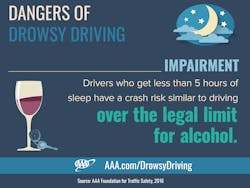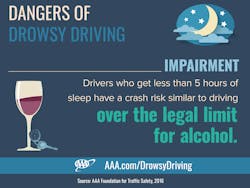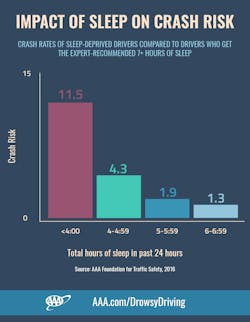That’s not particularly new or shocking info, but here’s the dirty not-so-little, no-so-secret truth about trucking (so consider this a public service reminder): Most drivers push too hard.
And this over-confidence is based on experience. We’ve gotten away with it before, and maybe a lot. It’s human nature—and a basic trait of a trucker—to assume that the rules for your average person don’t apply, especially to a professional such as yourself with as job to do.
But that’s just a gamble, pure and simple. Consider, truck driver, how much you’re aggravated by the idiot 4-wheeler drifting out of a lane right next to you. More often than not these days, that amateur is distracted by a phone, or a child, or a mirror.
Or a beer. Once again, the data puts the risk of driving while sleep deprived in perspective: The estimated crash risk associated with driving after only 4-5 hours of sleep compared with 7+ hours is similar to the National Highway Traffic Safety Administration’s estimates of the crash risk associated with driving with a blood alcohol concentration (BAC) equal to or slightly over the legal limit in the US (0.08). And sleep deprivation adds up quickly: The crash risk associated with having slept less than 4 hours of sleep is comparable to the crash risk associated with a BAC of roughly 0.12-0.15.
If there’s a trucker in the U.S. who routinely risks driving above the legal alcohol limit, keep him or her away. Indeed, the number of such violations is so small FMCSA has lowered the threshold for mandatory random fleet testing. But, show of hands: Who’s resisted the urge the “rest your eyes” or thought that pulling over for a bit would be a good idea—but you didn’t because you had miles to make?
Science says you might as well have had a beer or two and continued on down the road.
Anyway, enough preaching. Here’s the chapter and verse:
- Six to seven hours of sleep: 1.3 times the crash risk
- Five to six hours of sleep: 1.9 times the crash risk
- Four to five hours of sleep: 4.3 times the crash risk
- Less than four hours of sleep: 11.5 times the crash risk
While 97 percent of drivers told the AAA Foundation they view drowsy driving as a completely unacceptable behavior that is a serious threat to their safety, nearly one in three admit that at least once in the past month they drove when they were so tired they had a hard time keeping their eyes open.
“Managing a healthy work-life balance can be difficult and far too often we sacrifice our sleep as a result,” said Jake Nelson, director of Traffic Safety Advocacy and Research for AAA. “Failing to maintain a healthy sleep schedule could mean putting yourself or others on the road at risk.”
Symptoms of drowsy driving can include having trouble keeping eyes open, drifting from lanes or not remembering the last few miles driven. However, more than half of drivers involved in fatigue-related crashes experienced no symptoms before falling asleep behind the wheel. AAA urges drivers to not rely on their bodies to provide warning signs of fatigue and should instead prioritize getting plenty of sleep (at least seven hours) in their daily schedules. For longer trips, drivers should also:
- Travel at times when normally awake
- Schedule a break every two hours or every 100 miles
- Avoid heavy foods
- Travel with an alert passenger and take turns driving; and
- Avoid medications that cause drowsiness or other impairment.
Again, by the time you catch yourself nodding off, you’ve already been asleep. That should scare you. And get you off the road. The life you save isn't just your own.
About the Author
Kevin Jones 1
Editor
Kevin has served as editor-in-chief of Trailer/Body Builders magazine since 2017—just the third editor in the magazine’s 60 years. He is also editorial director for Endeavor Business Media’s Commercial Vehicle group, which includes FleetOwner, Bulk Transporter, Refrigerated Transporter, American Trucker, and Fleet Maintenance magazines and websites.


